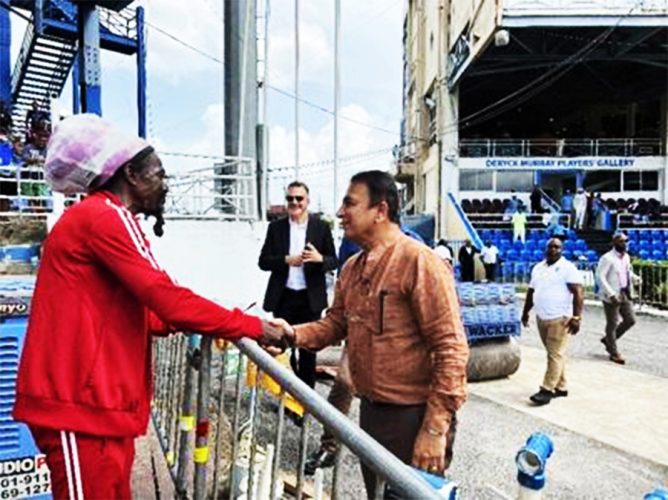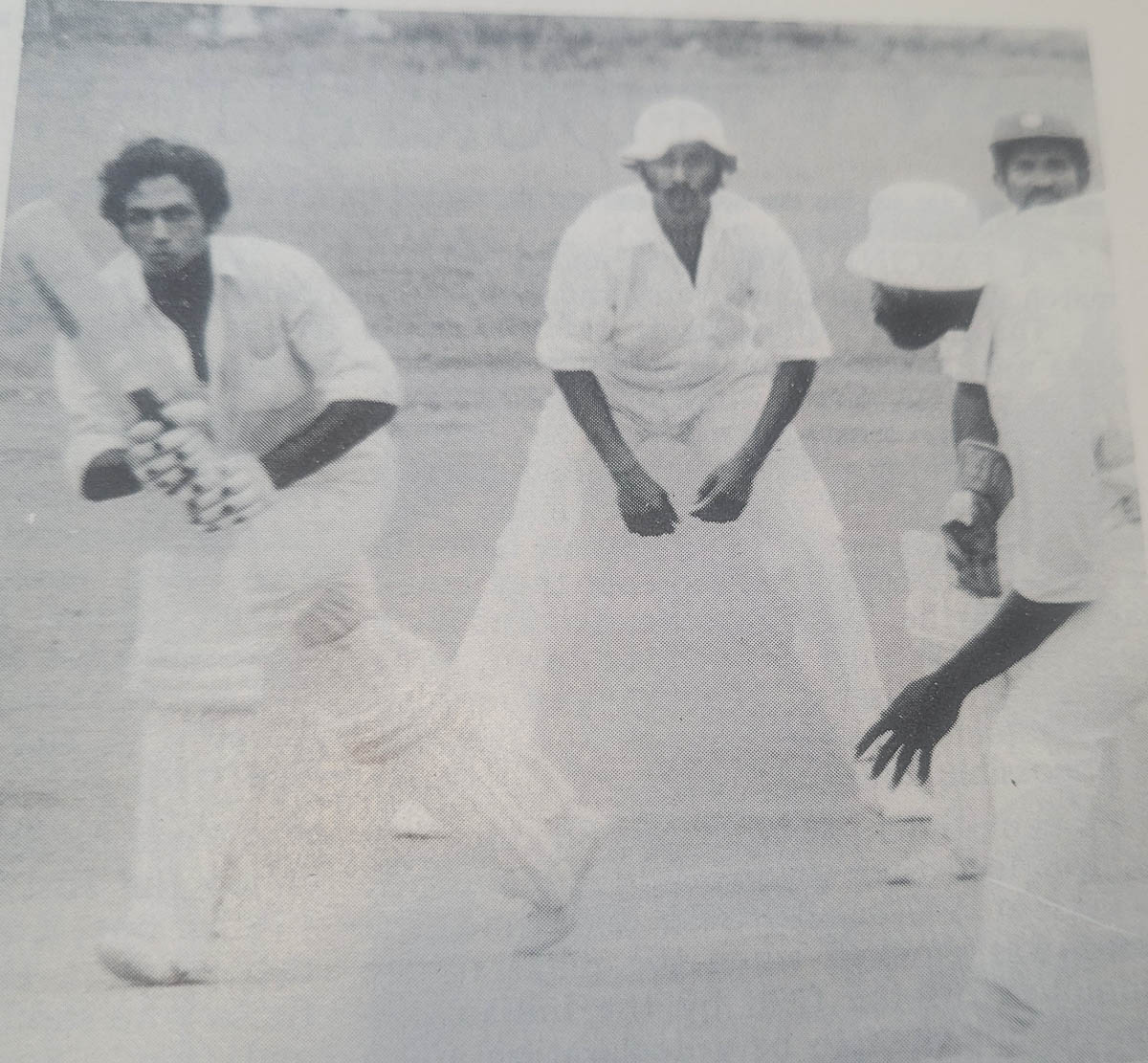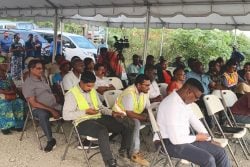In this week’s edition of In Search of West Indies Cricket Roger Seymour recalls India’s scintillating fourth innings’ run chase at the Queen’s Park Oval, in Trinidad, in 1976.
Prologue
Several years ago, most of the walls of the upper flat of the Men’s Pavilion of the Georgetown Cricket Club (GCC), at Bourda, were adorned with one of the world’s finest collections of historical photographs of West Indies cricket. The mostly black and white images, which date back to the early 1900s, provided a comprehensive pictorial record of West Indies Test teams through the years. In the words of one overseas visitor, “Perhaps, only the MCC [Marylebone Cricket Club] in London, and the Melbourne Cricket Club in Australia, both of which have actual cricket museums, have larger collections.” In fact, the MCC Museum, established in 1864, traces the history and development of the game of cricket, and is the one of the oldest sports museums in the world.

On the western wall of the narrow ‘bridge-corridor’ connecting the upper levels of the Men’s and Ladies’ pavilions at the GCC, among the portraits of the various teams and players – West Indies, Guyanese and GCC – there was a large mount with four vignettes, depicting different sections of the Bourda sward completely covered with water; empty stands serving as a silent backdrop. Over the course of time, the harsh sunlight had faded the colour stills which appeared to depict a boycotted rowing regatta slated for a river or a lake in a town on America’s eastern seaboard, rather than a flooded cricket ground in the West Indies. The framed record? A gift to the GCC from the then British High Commissioner to Guyana, depicting the state of the ground during the first week of April 1976, when the Third Test of the West Indies – India series had been scheduled.
Tough start
The Indian cricketers arrived in Guyana on Tuesday, 30th March, 1976 and it began raining in Georgetown at 8.30 pm that day. It fell virtually non-stop for 14 hours, and by the time it subsided Wednesday midday, six inches of rain had fallen. The capital city had endured its wettest day in March, since 15th March, 1925.
Not a single ball was bowled in the match between India and Guyana, which had been arranged for 1st to 4th April, at Bourda. It was a huge disappointment for Guyanese fans. It had been billed as the farewell, home first-class match for local hero and doyen of West Indian spinners Lance Gibbs, the then newly-crowned world record holder for Test wickets, who had been appointed Guyana’s captain for the occasion. On 5th April, the West Indies Cricket Board of Control announced the cancellation of the remainder of the Guyana leg of the India Tour due to inclement weather rescheduled the Third Test at the Queen’s Park Oval, which had hosted the drawn Second Test.
The Indian cricketers had not been enjoying their Caribbean sojourn. Following their three Test series in New Zealand, (tied 1 – 1), they had embarked on an arduous 62-hour journey in economy class to the other side of the world, with long stopovers. Within a day of their arrival, virtually no time to acclimatize to the vastly different playing conditions, they were on the field for their opening fixture against the Windward Islands at Arnos Vale, St Vincent, 26 – 28 February. The hosts, arguably the weakest territorial side at the time, compiled 306 in their first innings, thanks to a fine century from Irving Shillingford, 127, and a solid innings of 72, from their Skipper, former West Indies wicketkeeper, Mike Findlay. In reply, the visitors mustered 238 for 8 declared, with opening batsman P Sharma, 53, and Surinder Amarnath, 60, leading the way. After scuttling the Windward Islands for 113 in their second innings, India had only 90 minutes to score 182, since both sides had spent too much time on their first innings.
Two days later, after a short flight to Montserrat, the Indian team faced the Leeward Islands at Plymouth. In a match heavily affected by rain, the touring team scored 206 for six declared off 88 overs on the first day, with P Sharma, 66, and Anshuman Gaekwad, 58, the main run scorers. The hosts were 176 for three when the game was called, with Jim Allen, 64, and M Camacho, 53, making the most of the opportunity to show their worth. The three Indian spinners of their fabled quartet, who participated in the game, Bhagwat Chandrasekhar (Chandra), Srinivas Venkataraghavan (Venkat), and Erapalli Prasanna, all managed to deliver 19 overs each, getting in valuable match practice.
On 5th March, following the two three-day affairs, the visitors began a four-day match against Barbados at Kensington Oval. The hosts continued their long tradition of strong displays versus touring teams, inflicting an embarrassing ten-wicket defeat on India with a day to spare. It was the third instance on consecutive tours that the island had tasted victory over the visitors. Scores: India, 210 for nine declared; Sunil ‘Sunny’ Gavaskar, 62, Albert Padmore, five for 42, & 150, Wayne Daniel, four for 24. Barbados, 323 for nine declared; J Newton, 84, E Trotman, 63, &, 38 without loss.
First Test, Kensington Oval, Bridgetown, Barbados, March, 10, 11, 13. The West Indies were showing no ill effects from the physical bruising and mental torment they had suffered in their disastrous 5 – 1 defeat in Australia a month prior. They quickly imposed their authority whilst capitalising on a plethora of missed chances offered by the ragged Indian fielding. India suffered their heaviest loss ever in the Caribbean, surrendering within three days by an innings and 97 runs. Bundled out for 177 by tea on the first day, as David Holford, the 35-year-old leg spinner, recalled after an absence of four years, had his best returns in 22 Tests, five for 23, aided by poor shot selection. The West Indies’ response of 448 for nine declared, was centred around a record third wicket partnership for West Indies – India Tests. Viv Richards (142) in his first Test innings in the Caribbean, and Alvin Kallicharran (93) added 220 at a run-a-minute pace to set the stage for Captain Clive Lloyd to hammer his tenth Test century (102) in his 50th Test match, as the hosts built a massive lead. Despite valiant efforts by Gundappa Vishwanath (62) Madan Lal Sharma and Mohinder Amarnath (25) India folded for 212 in their second innings. The lopsided victory cast huge doubts on India’s ability to compete with their hosts.
The tour then shifted to the Queen’s Park Oval, Port-of-Spain, Trinidad, the scene of their 1971 series triumph. In the territorial match versus Trinidad and Tobago, India accumulated 345 for eight declared on the first day, as Gaekwad (114), Britesh Patel (66), Mohinder Amarnath (58), and Gavaskar (52), enjoyed good innings. Rain over the next two days severely limited play and Trinidad floundering at 98 for five, recovered to 303 all out. The Gomes brothers, Larry (110) and Sheldon (80) batted through, the weather permitting three and half hours of play on the third day, in a sixth-wicket partnership of 155. India utilised the remnants of the last day for batting practice, scoring 185 for five, as Gavaskar, India’s leading batsman, followed his innings half century with 57.
Second Test, Queen’s Park Oval, March, 24, 25, 27, 28, 29. India, artfully led by Bishen Singh Bedi, the fourth member of their spin quartet, just failed to convert their superior performance into a series-levelling victory. The complete loss of the first day’s play due to rain was a critical factor as time expired with the West Indies battling to save the match. Invited to bat first by India, the West Indies were reduced to 52 for four by lunch on the second day, echoing the top order collapses of the recent Australia tour. Richards (130), continuing in his rich vein of form completed his second consecutive century, and wicket-keeper Deryck Murray (46) weathered the storm whilst adding 122 for the fifth wicket as the West Indies rallied to 241. Bedi’s five wickets for 82, included Richards, Murray and Kallicharran. India’s reply of 402 for five declared was built around Gavaskar’s disciplined 156, which spanned eight hours and 35 minutes, ably supported by Patel’s maiden Test century of 115*. Their fifth wicket partnership of 204 established a new record for India in Tests, erasing the 1965 mark of 190 set by the Nawab of Pataudi and Chandu Borde. Confronted with a deficit of 161, the home team were in dire straits with 94 for three at lunch on the final day. Lawrence Rowe and Lloyd were at the wicket. A critical chance off Lloyd, then 27, was miffed soon afterwards, when Patel collided with the substitute fieldsman, Eknath Solkar offering a golden opportunity to level the series. The ninth-wicket pair of Bernard Julien and Andy Roberts defied the world’s most potent spin attack for 50 minutes before Bedi called off the siege in the 13th over of the last hour with the West Indies leading by 54 runs.
Return to Port-of-Spain
Third Test, Queen’s Park Oval, March, 7, 8, 10, 11, 12. Both teams made two changes for the Third Test. With the England Summer Tour in mind, the West Indies selectors opted to rest Roberts’ overworked ankles (after almost two years of continuous cricket) with full pay for the final two matches. His stand-in Wayne Daniel, the young fast bowler, who had been named in the squad for the match at Bourda, was replaced by Imtiaz Ali, the Trinidadian leg spinner, who had been the top wicket taker in the recently concluded Shell Shield Tournament. Padmore, the Barbadian off spinner took Holford’s slot in the line up. Gaekwad, who missed the Second Test with an injury, replaced young Dilip Vengsarkar, and Solkar came in for Surinder Amarnath.
Lloyd chose to bat after winning his first toss in eight Tests, and the West Indies were soon reduced to 52 for three, with Chandra snaring all the wickets. Yet again, Richards, in his best innings of the series, commandeered the spin attack on the way to his third century in as many matches. With Lloyd (68), he added 124 for the fourth wicket, and 106 in a sixth-wicket partnership with Julien (47). The West Indies, envisioning a massive score, reached 320 for five at the close of play, with Chandra the sole wicket taker.
The next day, the West Indies, trying to force the pace, lost their remaining wickets for 39 runs in 45 minutes, with Chandra capturing the dangerous Richards (177) to finish with six for 120. Bedi took care of the four tail-enders. India struggled throughout the day against the tight West Indian attack, finishing on 169 for five. The law of averages had finally caught up with Gavaskar; he was dismissed for 26, lbw to Holding, the first time the “Little Master” had failed in a match at the Queen’s Park Oval. In 1971, Gavaskar had scores of 125 & 63 vs Trinidad, 65 & 67* in the First Test (debut Test) which India won by seven wickets, 124 & 220 in the Fifth Test (In Search of West Indies Cricket, ‘The Port-of-Spain Masters’, 13 March, 2016).
Heading into the rest day, the West Indies clearly held the upper hand. On Saturday’s resumption, the pendulum remained solidly in favour of the hosts. India conceded a first innings lead of 131 runs, with Madan Lal (42) and Vishwanath (41) being the top scorers. Holding returned his best figures in Tests, capturing six wickets for 65 runs off 26.4 overs. India bowled and fielded tightly as the West Indies, crept to 132 for three at the close, with Kallicharran (37*) and Lloyd (19*) at the wicket. The hosts, having lost Richards for 23, much to India’s relief, led by 263 with seven wickets in hand and two days remaining.
Fifty-five minutes after lunch on Sunday, Lloyd declared with the West Indies on 271 for six. Kallicharran (103*), his eighth century in 31 Tests, and Holding (17*) were at the wicket. India had the daunting task of scoring 403 to win, or surviving eight hours and 55 minutes to draw the match. Only once had a team scored 400 to win a Test match. The Australians, led by Don Bradman (173*) and Arthur Morris (182) scored 404 for three, to beat England in the Fourth Test at Leeds in July, 1948. The odds were clearly stacked against India whose slim hopes of saving the match rested squarely on the shoulders of the diminutive pair Gavaskar and Vishwanath. The former immediately seized the initiative, launching an attack on the West Indies bowling on the placid pitch, striking 12 boundaries, as he raced to 85 not out by the close of play, with India perfectly poised at 134 for one. Gaekwad, who shared an opening partnership of 69 with Gavaskar, was the singular West Indian success of the afternoon, caught at slip by Kallicharran off the Trinidadian left arm spinner Raphick Jumadeen.
12th April, 1976
When play resumed, India required 269 runs to win and West Indies were desperate for a wicket. Having just completed his eighth Test century, his sixth against the hosts, Gavaskar, aiming to push the score, nicked an edge to Murray off Jumadeen, who was celebrating his 28th birthday. Gavaskar (102) and Mohinder Amarnath had added 108 for the second wicket. Vishwanath joined Mohinder, as the West Indies restricted India to just 22 runs in the second hour. At lunch, the target was 206, with time on India’s side.
Forty-five minutes after the interval, with 26 added to the score, Lloyd claimed the new ball, 29 overs after it was available. It was a critical moment. Julien bowled loosely and Vishwanath began to hit his stride; 37 runs came off the first eight overs. Lloyd resorted to his spin attack, but neither Padmore nor Jumadeen, nor Ali could contain Vishwanath, who deftly used his feet to counter them. Meanwhile, Mohinder steadfastly held the fort at the other end. In the 1974/75 series in India, Vishwanath had compiled a second innings century (139) in the Third Test at Calcutta and India down 0 – 2, won by 85 runs to keep the series alive. In the Fourth Test at Madras, his match top score of 97 was the difference in the game. India won a low-scoring contest by 100 runs to level the series. Once again, he led the charge as India galloped to 289 for two at tea. The pendulum was now swinging heavily in India’s favour, with 114 required off one and the mandatory 20 overs.
As the word of India’s chase spread, the crowd grew and support for each side appeared to be equally divided. A few clouds appeared and a section of the home supporters began a rain dance, only to witness their quick departure. Vishwanath duly completed his fourth Test century, before he was run out. Mohinder played a ball to mid wicket, and Vishwanath, backing up, passed the point of no return. His masterful innings of 112 spanned three hours and 40 minutes and contained 15 boundaries, with the only blemish being a missed stumping off Padmore when 65. The third-wicket partnership had yielded 159 runs and placed India on the doorstep of an historic victory. Vishwanath returned to the pavilion to a standing ovation from the entire ground. India required 67 off 21 overs.
Patel, the new batsman, applied the icing to the cake, taking boundaries almost at will, as the West Indies wilted. Mohinder (85), son of the famous Indian captain Lala Amarnath, in only his seventh Test, was eventually run out by Lloyd’s direct throw from extra cover. His anchoring innings had occupied seven hours and 20 minutes, with a single chance, a regulation return catch to Ali at 35. As Bedi later acknowledged, “It was a knock that actually paved the way to our triumph.”
When Patel (49*) cut Ali to the third-man boundary off the last ball of the thirteenth over of the mandatory 20, the crowd swarmed onto the field to hail one of the great victories in the annals of Test cricket. Scores: West Indies, 359 & 271 for six declared. India, 228 & 406 for four.
Postscript
The Fourth Test in Jamaica was marred in controversy with the West Indies winning by ten wickets, as India declared their second innings closed with five batsmen absent hurt.
Gavaskar would write later, “I was confident that we could save the game because the wicket was still good; but the thought of winning never entered my mind.”
India’s successful run chase was the watershed act of four such in a decade. In the Fifth Test of the 1977/78 series versus Australia at the Adelaide Oval (tied at 2 – 2), India amassed 445, lost by 47 runs. (Mohinder Amarnath 86, Vengsarkar, 78, Vishwanath, 73)
In the Fourth Test of the 1979 series in England at the Kennington Oval, India set 438 to win, were 429 for eight when time expired (Gavaskar, 221).
In the First Test of the 1986 series versus Australia at Chennai, India scored 347 to tie the game (Gavaskar, 90, Mohinder Amarnath, 51).
It was the last time Lloyd played two spinners in a Test match.
In July, 2023, Gavaskar was the guest of honour at the Queen’s Park Oval for the 100th Test Match between India and the West Indies. At his ‘second home’ Gavaskar scored 793 runs in five Test matches, with four centuries and two 50s, at an average of 99.13.






